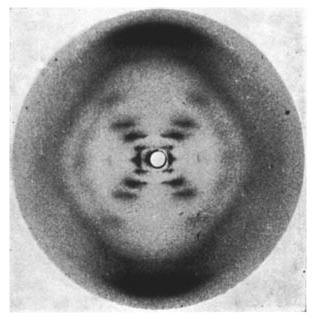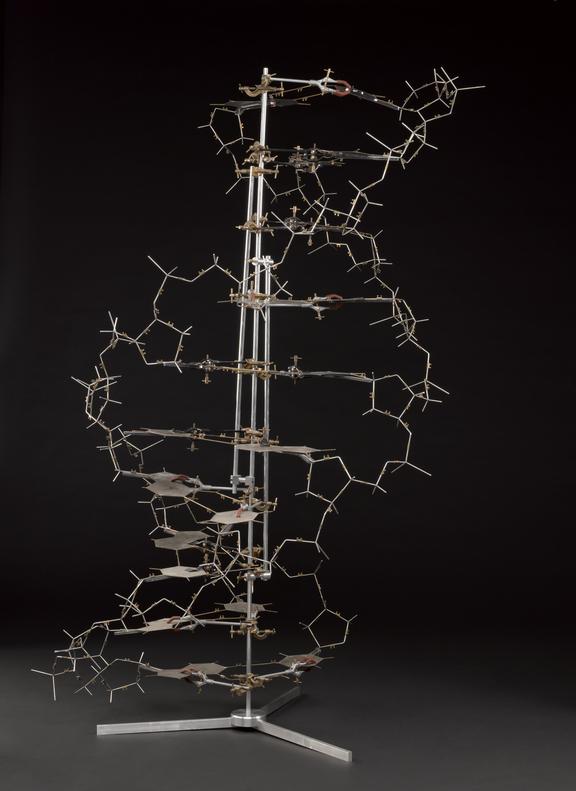History of DNA
- The discovery of the shape of DNA in %%1962%% by Watson and Crick was the most important biological discovery of the century. This is because DNA is the mechanism of heredity in all living things and, therefore, is the most important biological molecule.
Griffith’s Experiment
- There were several other scientists that made the discovery of DNA possible. In %%1928%%, Frederick Griffith did an experiment with bacteria that gave us the first hint of DNA. Griffith was experimenting with two types of bacteria. One type caused pneumonia and the other did not. We call the type that caused disease the virulent strain and the type that did not cause disease the nonvirulent strain.
- First, Griffith injected the nonvirulent, or rough, strain into mice and all the mice lived. This was expected. Then, he injected the virulent, or smooth, strain into mice and the mice died. This, too, was expected.
- Next, he tried something different. He killed the bacteria using heat. He injected the heat-killed virulent (smooth) bacteria into the mice. They all lived. Still, his results were as he expected. Finally, he mixed the living nonvirulent (rough) bacteria with the heat-killed virulent (smooth) bacteria. The mice died. This was not expected at all and shocked Griffith. Something caused the mice to die, even though the heat supposedly had killed the virulent bacteria. Griffith called this process transformation.
- Today, we know that the DNA of the virulent (smooth) bacteria survived the heat. The DNA of the virulent bacteria was transferred into the nonvirulent (rough) bacteria in a process known as horizontal gene transfer. After this happened, the living nonvirulent bacteria had the ability to make the mice sick and kill them because they had the DNA of the virulent bacteria integrated into their own DNA. At the time, Griffith didn’t know why this happened, just that it happened.
Oswald and Avery
- Almost 20 years later, in %%1944%%, Oswald and Avery decided to repeat Griffith’s experiments. Now the field of microbiology was beginning to come of age. This knowledge enabled these scientists to determine that DNA was the transforming factor in Griffith’s experiments.
Hershey and Chase
- Eight years later, in %%1952%%, Hershey and Chase experimented with bacteriophages, which are viruses that infect bacteria. These viruses inject their DNA into bacteria and hijack the bacteria to serve as virus factories, churning out new bacteriophages.
- Hershey and Chase labelled the DNA of the bacteriophages with a radioactive marker. They found that the radioactive marker (and thus the DNA) was inside the bacteria and no longer in the bacteriophage. Next, they put radioactive markers on the proteins of the bacteriophage. When they did this, the radioactive marker stayed in the virus and was not present in the bacteria. This led them to conclude that DNA was the genetic material, not the proteins.
The Race for a Nobel Prize
- At this point, we knew DNA was the mechanism for heredity, but we had no idea what it looked like. In the %%1950s%%, it seemed like everyone in the scientific community was looking for DNA because they knew that whoever figured out the structure of DNA would likely win a Nobel Prize, which is the most prestigious award in the scientific community.
- Three groups emerged as the leading contenders in the race to discover the structure of DNA: a team led by Linus Pauling, a scientist who had already won 2 Nobel Prizes, Rosalind Franklin and Maurice Wilkins, and Francis Crick and James Watson.
- Pauling was trying to build a model of DNA. He proposed a triple-helix model, which was not close to what we now know as the double-helix shape of DNA.
- The other two teams were closer and, conveniently, were working at two different universities in Cambridge, England.
- Rosalind Franklin and Maurice Wilkins were working at King’s College and Watson and Crick were working at the University of Cambridge. Franklin and Wilkins decided to approach the problem using x-ray crystallography, a relatively new technology. They were hoping to get an image of DNA. This technology was promising but very tedious.
- Watson and Crick decided to try to build a model. First, they spoke to Erwin Chargaff. He found something interesting in DNA. He found that DNA had adenine and guanine, which he called purines. He also found that DNA had thymine and cytosine, which he called pyrimidines.
- Whenever he looked at the composition of DNA, he found that there was always the same amount of thymine and adenine and the same amount of cytosine and guanine. He called this Chargaff’s Rule.
- So, Watson and Crick knew that adenine and thymine had to be paired and cytosine and guanine had to be paired. But they still didn’t have an idea of the shape of DNA.
- Watson decided to go visit Wilkins and Franklin. Wilkins showed him the image they had recently taken of DNA, now known as Photo 51.

- As soon as Watson saw the image, he knew DNA was shaped like a double helix.
- He raced back to the lab and worked furiously with Crick to build a model of the shape of DNA, which is now on display at the National Science Museum of London.

- In %%1962%%, Watson, Crick, and Wilkins were awarded the Nobel Prize for their role in the discovery of the shape of DNA. Unfortunately, Rosalind Franklin passed away from cancer that she had most likely gotten from exposure to radiation during her x-ray crystallography experiments and the Nobel Prize is only awarded to living scientists.
- It took several people many years and lots of hard, creative work to discover DNA and its shape. The discovery of the shape of DNA was quite possibly the most significant biological discovery of the twentieth century. DNA, being the mechanism for heredity in living organisms, makes it the most important molecule for life on Earth.
- The discovery of DNA has expanded our understanding of the natural world. It has paved the way for the study of genetics, which has allowed us to understand how organisms pass on their traits to their offspring.
Edited: 01 December 2022